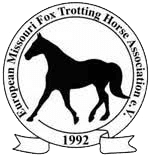The breeding book of the Missouri Fox Trotting Horse breed in Europe is managed by the European Missouri Fox Trotting Horse Association e.V. The legal basis of these principles is the breeding program of the EMFTHA e.V., all relevant European Union regulations and the Official Rule Book of the Missouri Fox Trotting Horse Breed Association (MFTHBA), Ava, Missouri USA.
The breeding principles for the breeding of Missouri Fox Trotting horse were developed following the “Official MFTHBA Rule Book”. In situations where their stipulated regulations were not compatible with the EU zootechnical legislation, regulations were established which come as close as possible to the definitions of the “Official MFTHBA Rule Book”.
These regulations established the principles for the breeding of the Missouri Fox Trotting Horse breed for all breeders’ associations, leading to the branch studbook. The breeders’ associations of the Missouri Fox Trotter are encouraged to follow the principles of the breeding book in the design of their breeding programs.

PSSM
For animal welfare reasons, animals bearing the dominant gene defect PSSM in homozygous or heterozygous form should not be bred. Carriers of the PSSM gene defect remain in the foal book for stallions or mares and cannot be entered in a higher class of the stud book for the Missouri Fox Trotter. A special identification will be issued in the equine passport. Homozygous carriers are excluded from the breed. Mares with positive heterozygous PSSM test may not participate in any premium / breeding program (premium mare, elite mare). They may only be paired to stallions that are not PSSM carriers. The dominant genetic defect is entered in the equine passport and published in the mare’s distribution plan.
All offspring of carrier animals must submit a PSSM test before entry into the breeding book. If the offspring are PSSM-free, they can be entered in the class of the studbook for the Missouri Fox Trotter according to their registration criteria. If both parents have a negative PSSM test, the offspring no longer have to submit a PSSM test.
Performance test
The performance test-exterior for mares and stallions is conducted to evaluate the breed value exterior (exterior appearance) with special consideration given to the horse’s motion sequence and performance test-riding. This serves to determine the breeding value of the riding performance for stallions, mares and geldings. Rideability and behavior of the horse is given considerable attention. The performance test-riding for Missouri Fox Trotter is a field test based on the EMFTHA performance test–riding guidelines. A successfully passed performance test-riding is a prerequisite for entry in the Studbook class I. A successfully passed composure test is a prerequisite for entry in the Studbook class II.
The performance test-riding includes the following test sections:
- Evaluation of interior features (disposition/tractability) during the exam day for all participating horses
- Evaluation of the horses under saddle in an arena with all participating horse (performance)
- Horsemanship Pattern
- A. Ridden composure test for all participating horses for entry in the Studbook class I
- B. In-Hand composure test for all participating horses for entry in the Studbook class II
The performance test for mares and stallions to determine the breeding value part of the exterior (“external appearance”) with special consideration of the movement sequence of the horses and performance tests Riding to determine the breeding value horse riding performance for stallions, mares and geldings are taking special care of the rideability and behavior of the horses carried out. The performance test-riding for Missouri Fox Trotter is a field test based on the EMFTHA performance test–riding guidelines. The passed performance test-riding is a prerequisite for entry in the Studbook class I. The passed, passed serenity test is a prerequisite for entry in the Studbook class II.
The performance test-riding includes the following test sections:
- hec interior features during the exam day for all participating horses
- Examinations of the courses under the rider in the arena for all participating horse (performance)
- Horsemanship Pattern
- A. Ridden serenity test for all participating horses for entry in the Studbook class I
- B. In-hand serenity test for all participating horses for entry in the Studbook class II
Equidenpass
Upon request, an Equidenpass, including a breed certificate will be issued for horses that can be registered in the breeding book of the EMFTHA according to the regulations of the DVO (EU) 2015/262 of the COM and the legal regulations of the livestock traffic regulation of 03.03.2010. The breed certificate must always be linked to an equine passport. The equestrian breeding passes of the EMFTHA have the color purple. With this pass you can quickly see if a Missouri Fox Trotter is registered in the studbook of EMFTHA e.V.
Stallion examination
The licensing is a decision of the EMFTHA concerning the use of a stallion within a breeding program. The EMFTHA allows the licensing of stallions who have reached the age of three years. The recommended target group for the licensing are five-year-old and older stallions. In particular, the characteristics of the external appearance play a part in the decision of the EMFTHA. The licensing includes:
- Identification and presentation of a stallion in-hand
- Evaluation of body measurements in accordance with the MFTHBA evaluation guideline
- Evaluation of the Gaits Walk, Flat Foot Walk and Fox Trot
- Submission of a veterinary health certificate and a negative PSSM test
For a stallion to be approved for licensing, the following conditions must be met:
- Equiden pass including pedigree certificate, as well as a MFTHBA Certificate of Registration must be available
- The stallion’s identity must be checked before approval by the studbook officer of the association or by a person commissioned by the studbook bookkeeper, based on the color and markings description and the transponder identification
- The pedigree examination of an EMFTHA approved veterinarian must be in place and in accordance with the requirements of this ZBO
- the applicant must submit a written statement on all known surgical procedures, including arthroscopy, for the purpose of physical correction
- Must have a negative PSSM test
More about PSSM
Source: www.tiergesund.de
PSSM is the abbreviation for the genetically caused metabolic disease “polysaccharide storage myopathy”, ie a polysaccharide storage disease of the musculature. In this disease, polysaccharides, sugar molecules are not metabolized properly, but stored excessively in the muscles of the horse. This applies to the so-called type 2 muscle fibers, which work quickly and powerfully.
This erroneous storage causes the excitation transmission to be disturbed in the muscle and it can eventually cause cell death. This causes extreme muscle pain and muscle cell damage which releases proteins into the bloodstream that can damage the kidneys.
Symptoms of PSSM
These mechanisms trigger a marked symptom when the muscles are stressed, which differs depending on the severity of the condition. Symptoms are the same as those of exercise-induced myopathy, commonly referred to as “crotch,” “lumbago,” or “holiday sickness.”
In mild conditions, first symptoms appear shortly after exercise (after about ten minutes). The affected horse often shows a curled back, overstretched, stiff hind legs and lack of movement. It can also lead to mild colic.
In moderate conditions, the first symptoms occur during work, about 20 minutes after onset. The gait stiffens, the affected horse stops frequently and starts to sweat. The musculature in the back, the croup and the hind legs is strikingly hard.
Initial symptoms of a severe attack may be manifest during stress. The horse may exhibit massive sweating, which can cause dehydration, as well as signs of colic and immobility. The musculature of the back, the croup and hindlegs is extremely painful and affected horses may also exhibit muscle fasiculations.
In addition, there is often an increased body temperature, circulatory weakness and the production of coffee-colored urine. This dark color of the urine is due to the release of a muscle protein myoglobin in massive damage to muscle fibers and is called myoglobinuria.
The hereditary disease is “autosomal dominant”. This means that a horse that has received a defective gene from both the father and the mother has an extremely high risk of developing PSSM and will also pass the gene 100 percent to its offspring. The horse is a so-called double carrier.
If the horse has only received a defective gene from one side, it is a so-called single carrier. Then the risk of developing PSSM is increased. In addition, it will pass the defect with 50 percent probability to its offspring.
Types of PSSM
There are two different types of PSSM that affect different genes. At the same time, type 1 (PSSM1) is much more common with about 90 percent of cases. This form of PSSM occurs more in heavily muscled horses.
Type 2 (PSSM2), on the other hand, is more likely to affect slightly muscled horses.
A genetic test that requires either a blood sample or mane or tail hair (with hair roots) may clarify the suspicion of PSSM type 1. The treating veterinarian can be interviewed about the required material and the costs of the test.
In the gene test on PSSM type 1, the following results are possible:
- Genotype N / N: no genetic defect (test negative)
- Genotype N / PSSM: single carrier
- Genotype PSSM / PSSM: double-carrier
If the test is negative despite the symptoms, PSSM Type 2 may be present. So far, this form of the disease cannot be detected by means of a genetic test, since the corresponding gene has not yet been identified. Here it is necessary to take a biopsy of the muscle and have it examined.
The genetic defect that leads to PSSM in a horse does not heal. However, symptoms may be prevented by proper feeding, training and keeping conditions. In this way, the quality of life and life expectancy of the affected horse can be maintained approximately normal.
The nutrition of a horse with PSSM should be changed, especially the energy source. It is advisable to refrain from feeding starchy and high-sugar feed, such as cereals or molasses. In addition to the need for maintenance, which should be largely covered with roughage, in increased energy demand situations, a horse feed with increased fat content may be used. In addition to a needs-based energy supply, it is also important to ensure an adequate supply of nutrient, especially vitamin E. A good vitamin E source is, for example, alfalfa. In addition, a high-quality mineral feed may meet the need for nutrients.
In addition to adapted feeding, the treatment of PSSM affected horses should be supplemented with regular exercise. The level of exercise should be adjusted according to the severity of the condition. Targeted training in riding as well as walking on the pasture can help with the symptoms.
Episodes of PSSM
With a laboratory examination of blood and urine, the veterinarian can assess the extent of resulting muscle damage from an attack. PSSM attacks weaken the affected horse, but the muscle can regenerate, depending on the severity of the injury. However, particularly severe attacks can be life-threatening without proper treatment.
Respect for proper feeding and caring for a horse can lead to a long and almost normal life despite PSSM. Nevertheless, the disease, which can be an unrecognized life-threatening condition for the horse, should not be underestimated. Additionally, it is important to recognize potential gene carriers in breeding programs.
